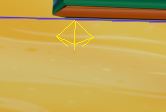Hello and welcome back to my blog. Last time we looked at scene assembly and what it entails. As we draw nearer and nearer to the end of the pipeline, I find myself getting more and more excited to see the finished result.
First up, we have Lighting.
Without adequate lighting in a scene, your final production will look somewhat underwhelming. Dark is one word that comes to mind. Of course, as outlined by the video tutorials that I have been following there are a few options when it comes to lighting.
The tutorial first had us configure our rendering settings, which as you can tell already lighting and rendering sometimes work closely together.
So, I configured my rendering settings to use Manta Ray for lighting at least. I later became unhappy with the rendering speed, and decided to use Quicksilver instead, as outlined by my tutor. I kept the lighting settings that manta ray had by default, and played around a bit with the sky dome, to achieve an image that didn’t look appallingly yellow.
I placed one Omni light, and then moved on to rendering out the final images.

There seem to be thousands of options to choose from, when it comes to rendering, so I didn’t adventure far from what was outlined this time. I chose to save my files as png’s as they can always be recovered, and for the next stage I need still images rather than a video file, in order to use them in Premiere Pro for its rendering as a mp4